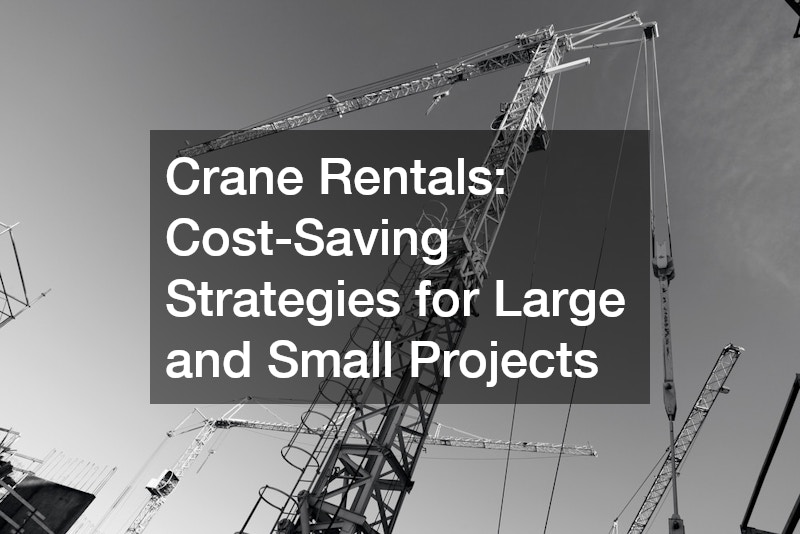When managing construction projects, whether large commercial builds or small residential upgrades, controlling costs is critical. One area where expenses can quickly escalate is heavy equipment. Crane rentals offer a flexible and cost-effective solution, allowing contractors and homeowners to access powerful lifting equipment without the long-term financial commitment of purchasing. By understanding how to optimise usage, select the right equipment, and plan efficiently, project managers can save money while maintaining high productivity and safety standards.
Choosing The Right Crane For Your Project
Selecting the appropriate crane is the first step toward cost efficiency. Different types of cranes are suited for varying tasks.
For instance, telescopic cranes are ideal for projects requiring vertical lifting over shorter distances, while mobile cranes can handle heavier loads across multiple sites. Assessing the specific needs of your project prevents overpaying for unnecessary capabilities. Smaller projects may benefit from compact cranes that can navigate tight spaces, whereas large-scale construction sites often require high-capacity cranes capable of lifting heavy materials efficiently. Consulting with a reputable rental company can help ensure you choose equipment that matches your requirements, avoiding unnecessary rental fees.
Another consideration when choosing a crane is the terrain and accessibility of the job site. Uneven surfaces or restricted access points can limit crane placement and operational efficiency. Evaluating site conditions in advance allows for the selection of equipment with appropriate stabilization and reach capabilities. For projects in urban areas, choosing a compact or mobile crane can minimize disruptions, while large construction sites may require cranes with higher load capacities and longer booms to reach distant areas safely. Factoring in these site-specific conditions can prevent costly delays and ensure smoother operations.
Scheduling And Planning For Efficiency
Proper scheduling is another crucial strategy for cost savings. Booking crane rentals for precise time frames minimizes downtime, which can be costly when equipment sits idle. Coordinating crane usage with other trades on the site ensures smooth workflow and prevents delays. For example, scheduling lifting operations immediately after foundation work or framing reduces the risk of conflicts with other tasks. Early planning also allows rental companies to provide the right crane without last-minute adjustments that often incur additional charges. For long-term projects, breaking the work into phases and arranging multiple short-term rentals can be more economical than a single extended rental period.
In addition to timing, anticipating project bottlenecks can enhance efficiency. Detailed planning of each lift, including materials to be moved and staging areas, allows teams to work methodically and avoid interruptions. Communication with subcontractors ensures everyone understands the crane’s schedule and limitations, reducing wait times and idle labor. Advanced planning also enables the rental company to provide the proper attachments, rigging, and safety equipment needed for the job. By integrating these logistics into the schedule, projects can maintain momentum and reduce unnecessary expenses.
Optimizing Labor And Operational Costs
Operating a crane efficiently requires skilled operators, and labor costs can significantly impact a project’s budget. Hiring certified operators from the rental company or ensuring your team has proper training prevents accidents and improves speed. Additionally, some crane rentals include operator services, which can reduce the need for additional personnel. Minimizing idle time and carefully planning lifts can prevent unnecessary wear and tear on the equipment, reducing maintenance fees. By tracking operational efficiency and aligning crane activity with project milestones, teams can maximise productivity while keeping overall costs low.
Monitoring operational metrics can further reduce expenses. Tracking lift times, fuel consumption, and operator performance can reveal areas where efficiency improvements are possible. Adjustments such as scheduling lifts during cooler parts of the day or consolidating multiple lifts into a single session can reduce labor hours and equipment use. Additionally, cross-training personnel to handle basic rigging and setup tasks can streamline operations and lower costs associated with relying solely on specialized operators. Consistent review and adjustment of operational practices ensure maximum value from crane rentals.
Maintenance And Safety Considerations
Safety and equipment maintenance are essential for protecting both workers and investment. Regular inspections and adherence to safety protocols prevent accidents that could lead to costly delays or repairs. Most rental companies maintain their cranes in optimal condition, which is a significant advantage over owning equipment, where maintenance responsibilities fall entirely on the owner. For small projects, this reduces the need for additional maintenance personnel or specialized tools. For larger projects, coordinating with rental companies ensures that the cranes remain in peak condition throughout the project, avoiding unexpected downtime that can compromise budgets and timelines.
Crane rentals provide a versatile and economical solution for both small and large construction projects. By selecting the right type of crane, scheduling rentals efficiently, optimizing labor use, and prioritizing maintenance and safety, project managers can reduce costs while maintaining productivity. Whether lifting materials for a home renovation or managing complex commercial construction, smart planning and strategic use of rentals ensure that projects are completed on time and within budget. Embracing these cost-saving strategies allows contractors and homeowners alike to benefit from the power and flexibility of professional lifting equipment without the financial burden of ownership.



